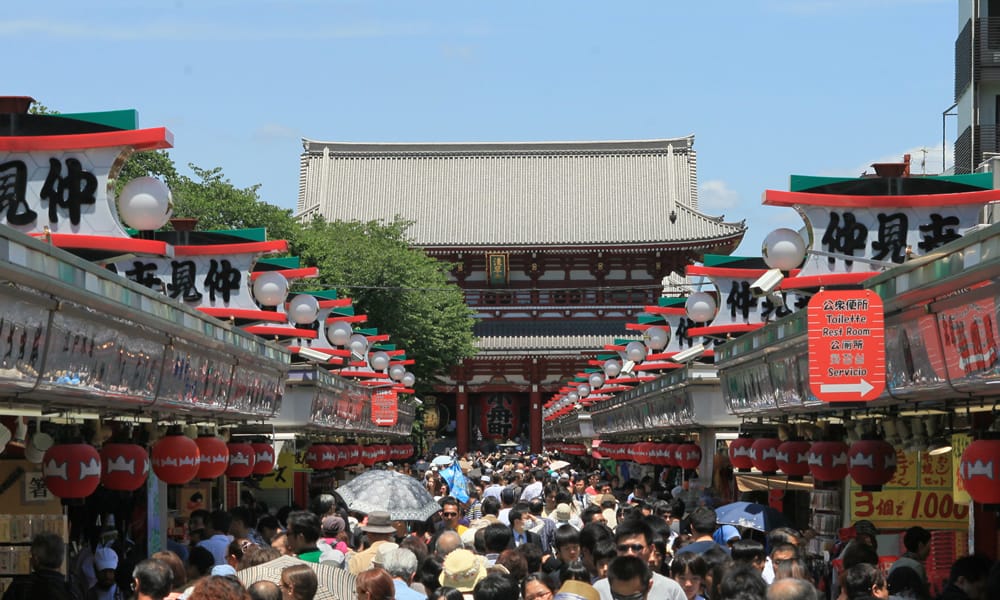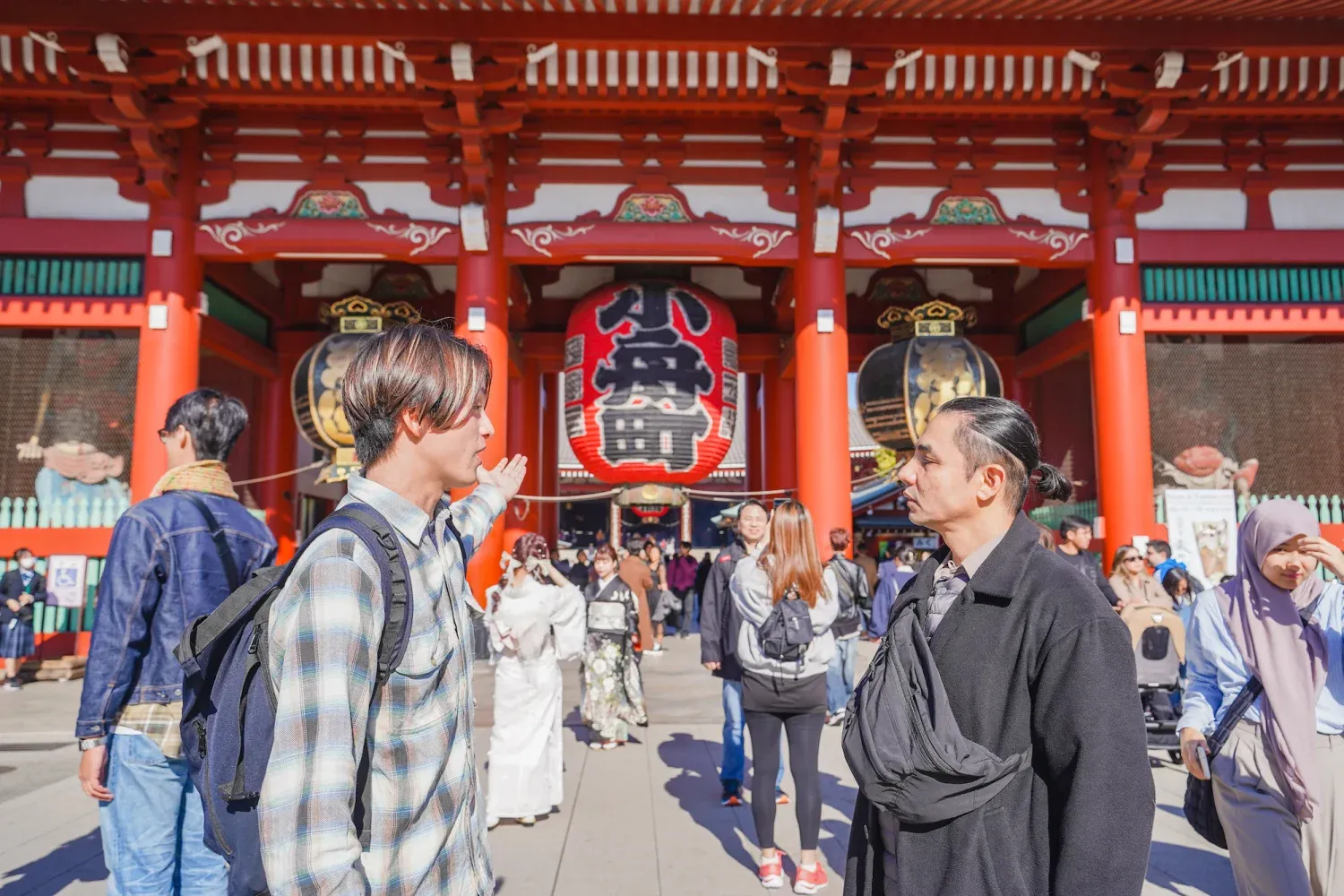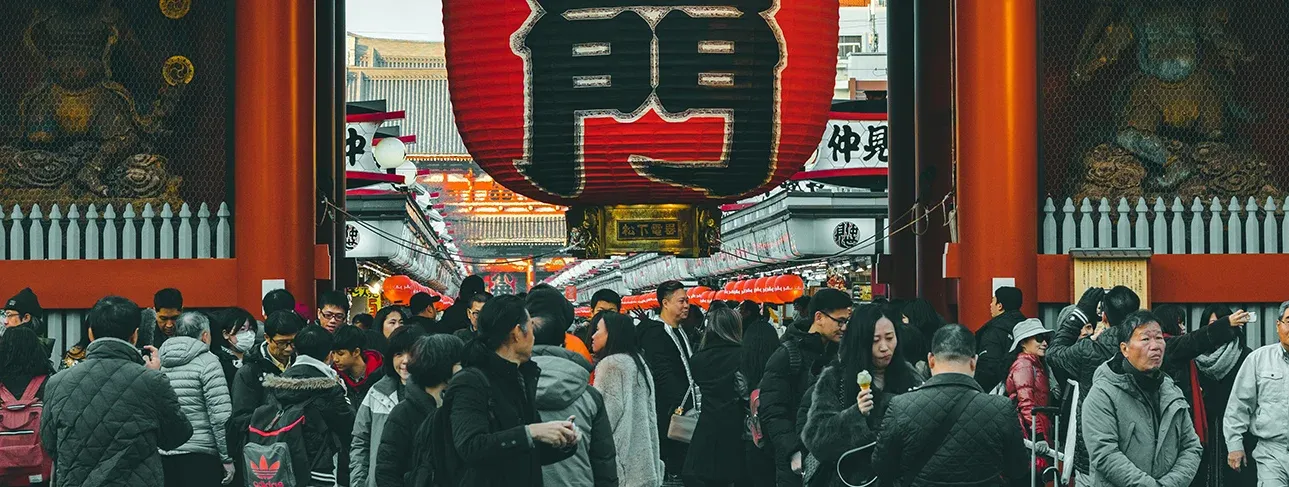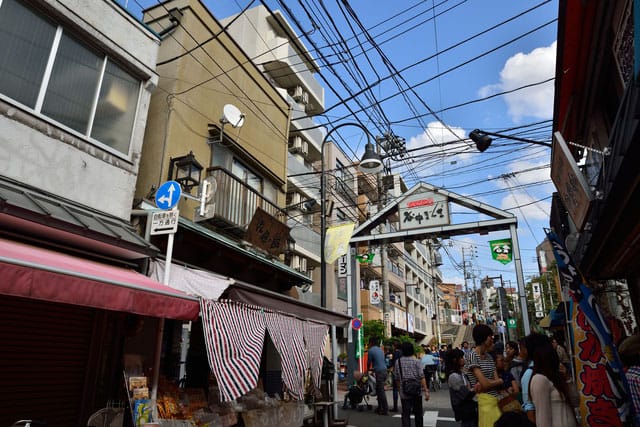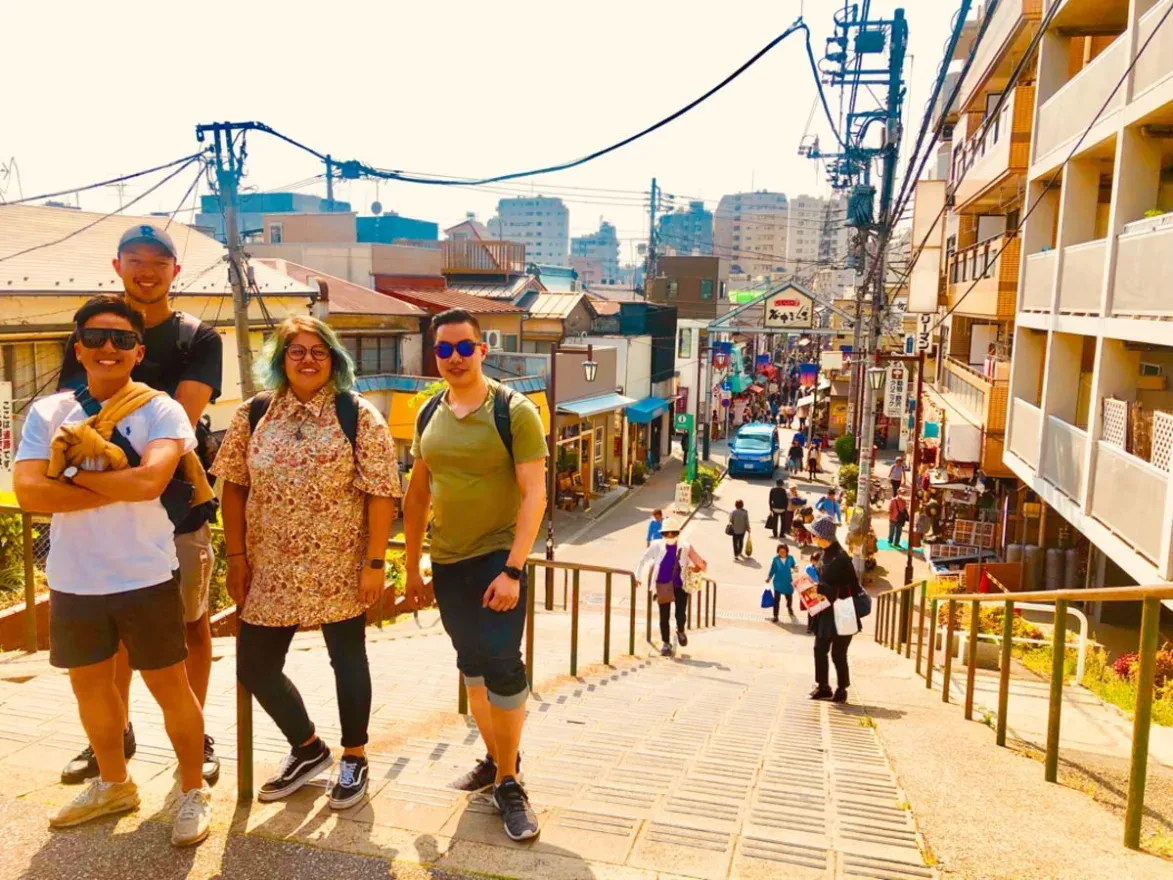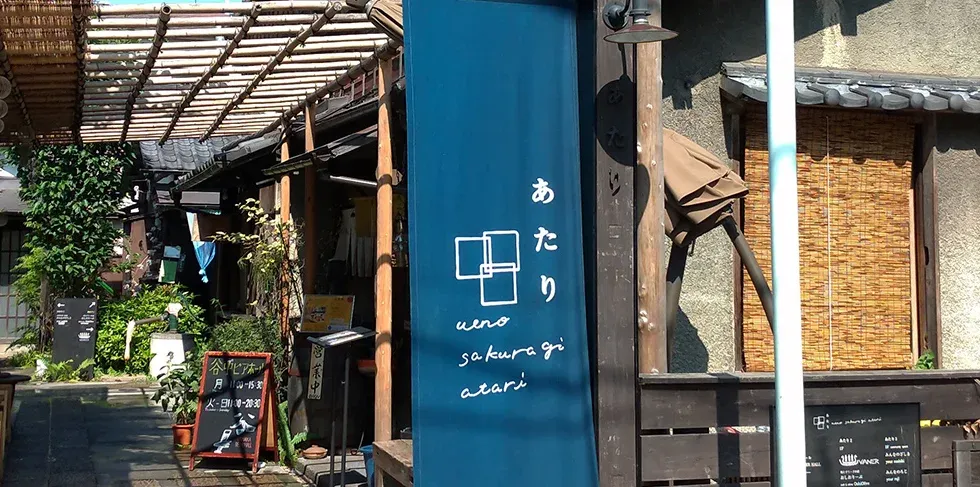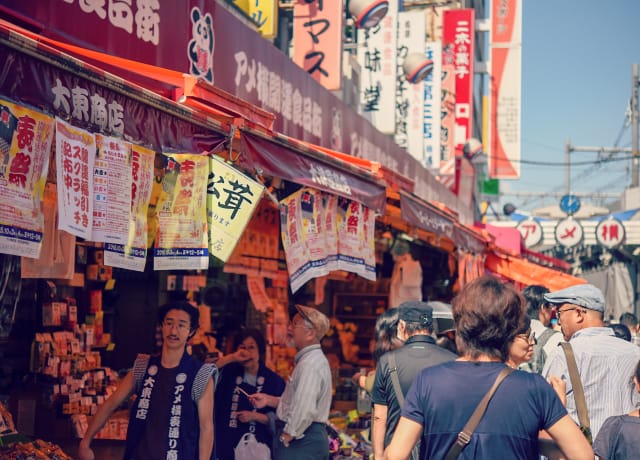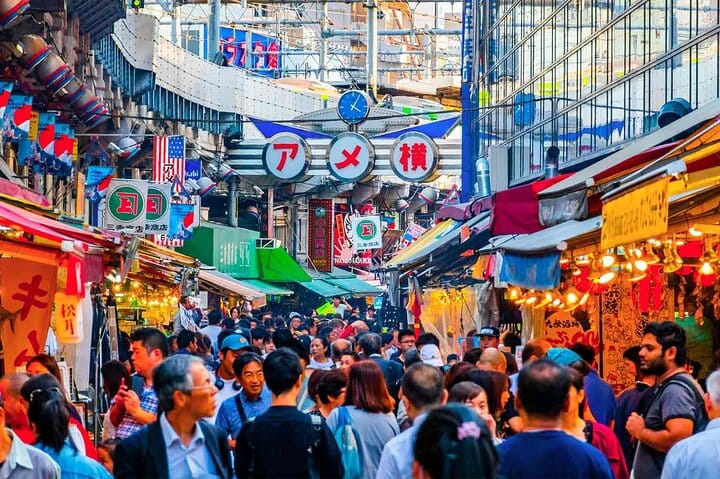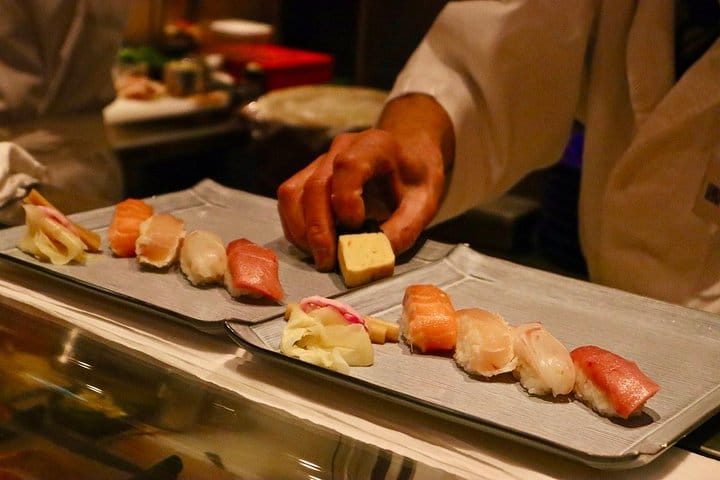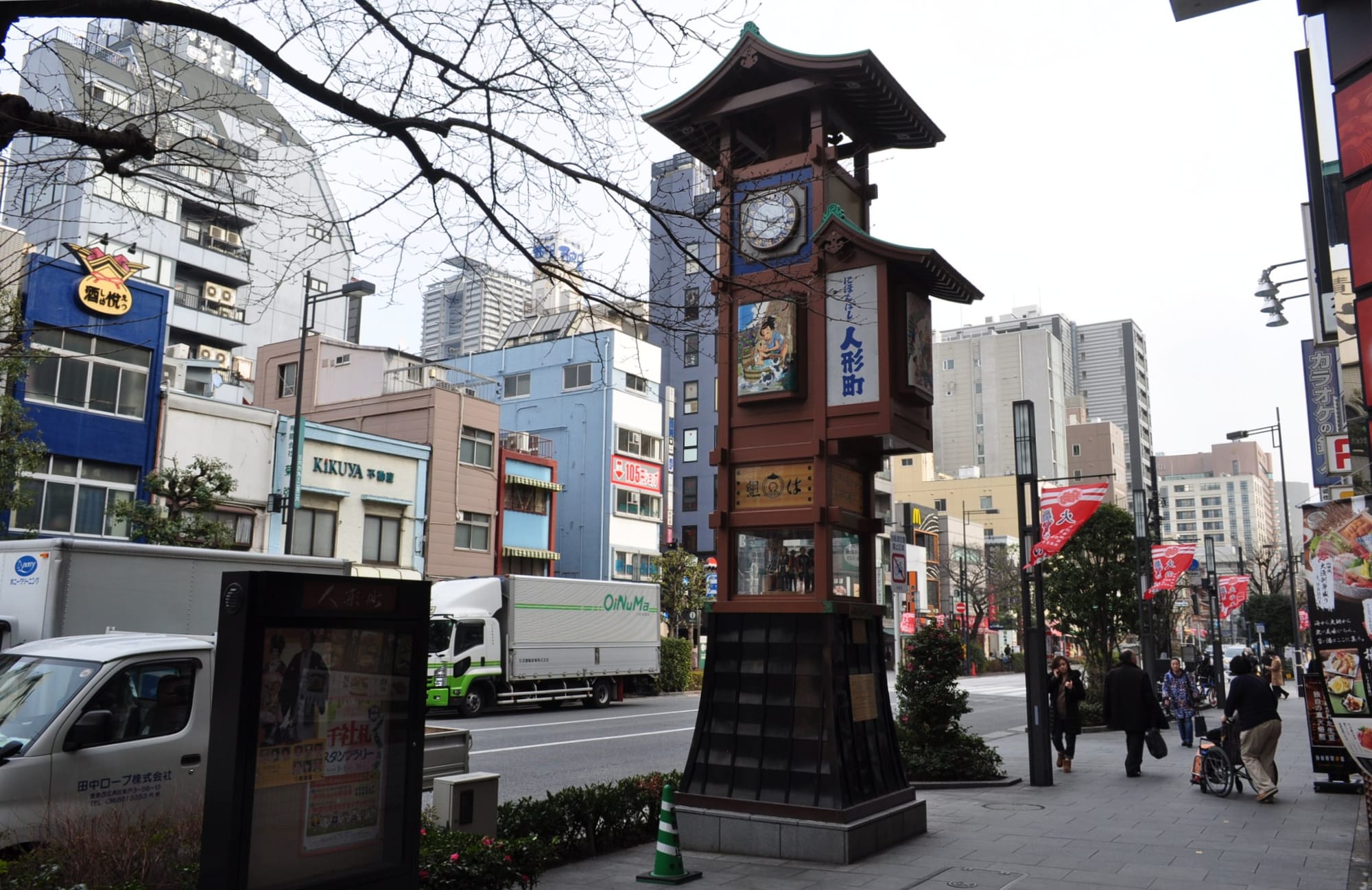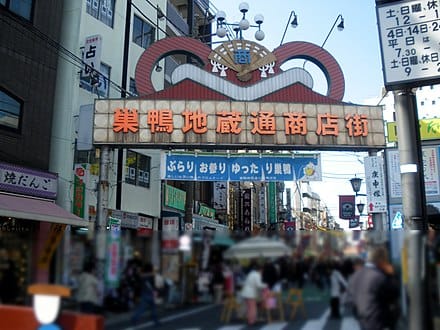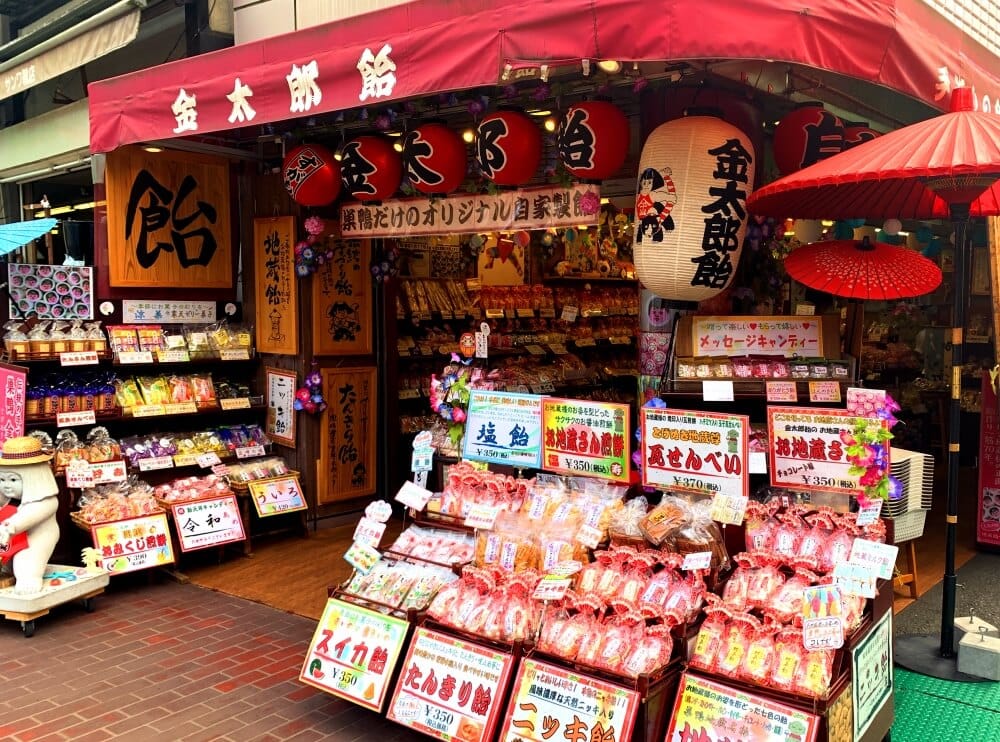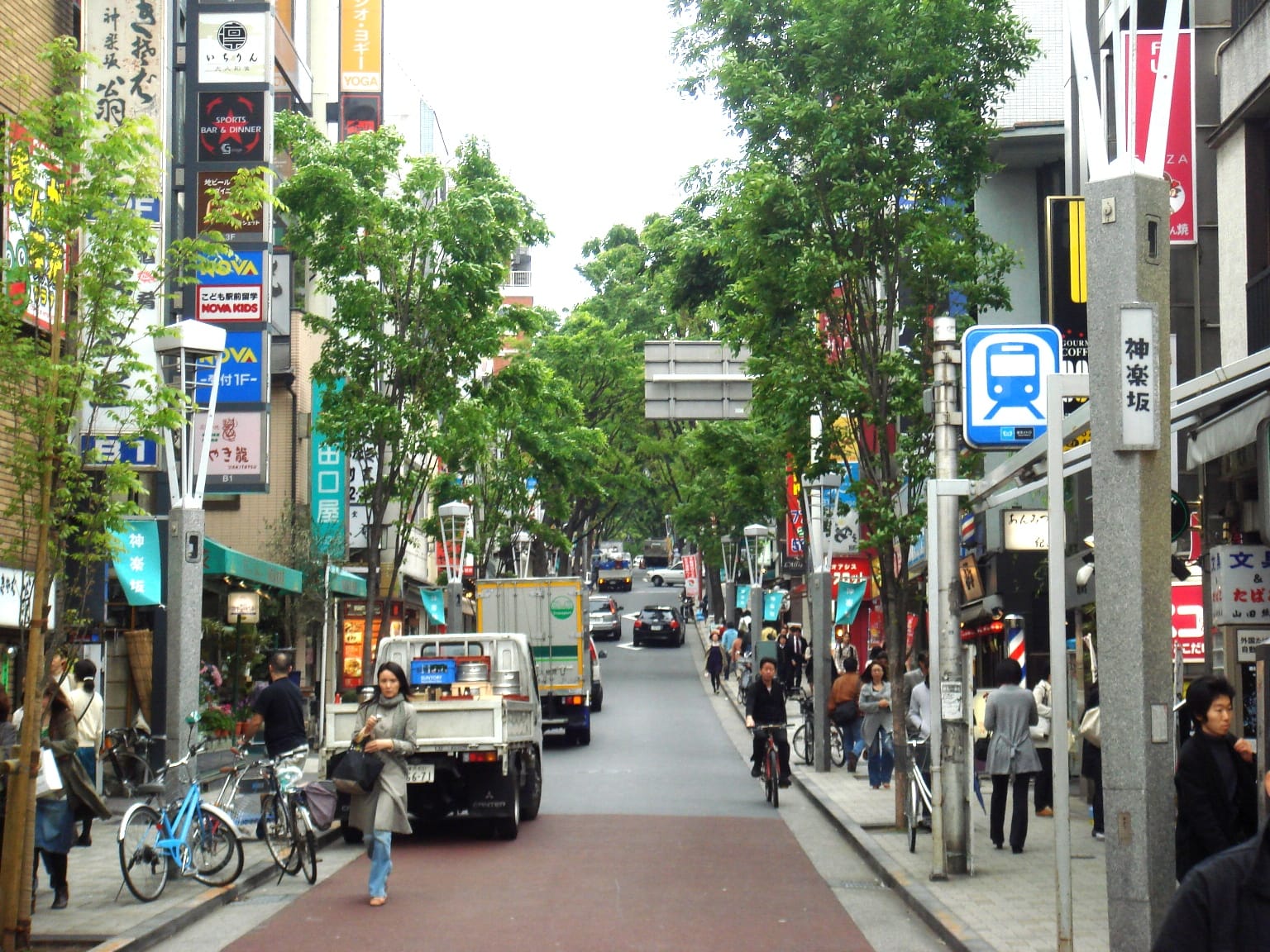What image comes to mind when you hear the word "Tokyo"?
Glittering skyscrapers, a modern city, shopping... However, that's not all there is to Tokyo's charm.
300 years ago, during the era called "Edo", Tokyo flourished as the world's largest city, surpassing even the populations of London and Paris, and was home to a diverse range of people from commoners to nobles.
In particular, the areas called "shitamachi", which are more prevalent on the east side of Tokyo as shown in the map below, are places where the culture and life of the common people from the past remain strong.
The bearers of Tokyo's culture are the common people, and the "shitamachi" areas that have not been turned into tourist spots are places where people continue to live and where you can feel the true local culture of Tokyo.
However, with the wave of redevelopment now reaching even the shitamachi, visiting these old neighborhoods that still retain their former appearance is becoming an even more valuable experience.
Whenever I walk through such old-fashioned towns, I feel a sense of nostalgia and reassurance that cannot be found in central areas like Shinjuku or Shibuya. In this article, I, a Tokyo local, will explain 6 recommended spots where you can enjoy such shitamachi neighborhoods.
I will also introduce tours that allow you to fully enjoy each spot. Local areas can be difficult for foreigners to enter, and English may not be understood, but by using a tour, you can enjoy the shitamachi with peace of mind.
Let's explore the old townscape of Tokyo together with me, a local!
Asakusa: The origin of Tokyo's old commoner culture
Source: Sensoji Temple Official Website
I will first introduce "Asakusa", which is the most famous shitamachi (old town) area in Tokyo.
Characteristics of Asakusa
Asakusa, known for Sensoji Temple, the oldest temple in Tokyo, is also a representative shitamachi neighborhood of Tokyo.
While having traditional and old charm, it is also a spot with good access and is an area you should definitely visit when traveling to Tokyo.
On the "Nakamise Shopping Street" leading to Sensoji Temple, there are shops selling traditional Tokyo sweets such as "dango", a soft rice cake, "ningyo-yaki", a snack made by wrapping red bean paste in wheat flour dough and baking it in the shape of animals, etc., and "kaminari-okoshi", a crispy rice cracker. Travelers can enjoy these as street food.
Every time I visit here, I am tempted by the aroma of dango wafting from the small shops and the piping hot ningyo-yaki. Recently, shops adding modern twists to these traditional sweets, such as sprinkling chocolate on them, can also be seen, and even I, a Tokyo local, enjoy Asakusa's food with a fresh feeling.
In the Asakusa area, there is also a lively izakaya (Japanese-style pub) street called "Hoppy Street". If you want to enjoy a more local Tokyo atmosphere while drinking, it is a must-visit place.
Also, near Sensoji Temple, there is an old artisan neighborhood called "Kappabashi Shopping Street". Here, you can get "food samples" that look exactly like real dishes, which are often seen in the show windows of Japanese restaurants. If you want to buy unique Japanese souvenirs, I recommend stopping by the shopping street and Hoppy Street as well.
Access
To access the Asakusa area, the Tokyo Metro or Toei Subway is convenient.
Tokyo Metro Ginza Line Asakusa Station: If you take the Tokyo Metro from Shibuya, you can directly access Asakusa in about 35 minutes, about 20 minutes from Akihabara Station, and about 5 minutes from Ueno Station. Exit 1 is close to Kaminarimon Gate, just a 1-2 minute walk away, making it the most convenient station.
Toei Subway Asakusa Line Asakusa Station: This line connects Asakusa and Tokyo Skytree. Oshiage Station is the closest station to Skytree, and is convenient for moving between Asakusa and Skytree. However, Sensoji Temple and Skytree are about a 20-minute walk apart, so I also recommend taking a stroll while enjoying the scenery of Tokyo's shitamachi and modern city blending together and the nearby Sumida River.
Recommended Tours
"Asakusa Cultural Walk & Matcha Making Tour" by Magical Trip
Source: Magical Trip
We at Magical Trip offer a 3-hour walking tour where you can fully enjoy the charm of Asakusa.
In addition to Sensoji Temple and Nakamise Shopping Street, which are representative historical spots in this area, you can also enjoy the shitamachi atmosphere of the more local Hoppy Street.
The tour also includes an experience of making "matcha", a traditional Japanese tea, and lunch enjoying "monjayaki" and "okonomiyaki", Japanese commoner's dishes made by mixing flour-based batter with meat and vegetables and grilling it.
Although it does not stop by the nearby famous spot Tokyo Skytree, if you want to fully enjoy Asakusa's history and local food culture, please consider this tour.
Click here for more details: Asakusa Cultural Walk & Matcha Making Tour
"Asakusa Free Walking Tour Tokyo" by Tokyo Localized
Source: Tokyo Localized
This tour provided by Tokyo Localized allows you to experience the main spots in the Asakusa area in about 2 hours.
In addition to Sensoji Temple and Nakamise Street, this tour also visits Tokyo Skytree, which is a bit far from these spots. Therefore, the time spent at each spot is not so long, but it is recommended for those who want to efficiently visit the landmarks in the Asakusa area.
Click here for more details: Asakusa Free Walking Tour Tokyo
Yanaka Ginza: Enjoy the shopping street and quiet historical spots
Next, I will introduce "Yanaka Ginza", a place that is perfect for feeling a more local atmosphere in Tokyo.
Characteristics of Yanaka Ginza
If you want to enjoy a shitamachi where time flows slowly even within Tokyo, I recommend the Yanaka Ginza shopping street and the surrounding area.
The shopping street has many shops selling Japanese delicatessen "sozai" that locals use for their everyday meals, and travelers can enjoy "sozai" as local street food.
There are also many restaurants and cafes offering cheap and delicious Japanese food, shops selling handmade bamboo crafts, traditional Japanese toys, and tableware, so you won't have trouble finding Tokyo souvenirs.
Around the shopping street, there are also plenty of historical spots such as Nezu Shrine with its rows of red gates (called "torii" in Japanese), Yanaka Cemetery where you can enjoy a tunnel of cherry blossoms in the spring, and Tennoji Temple.
Furthermore, as a cat lover, this neighborhood is actually quite exciting for me. Yanaka Ginza, with its intricate narrow alleys and low traffic suitable for cats' lives, is also an area where people have loved the "town cats" for a long time.
Therefore, there are shops selling cat-related items and cafes where you can interact with cats scattered mainly around the shopping street, making it a shitamachi where cat lovers will definitely smile!
Related Article
・Yanaka Ginza Guide: Experience the Local Life in Tokyo's Old Neighborhood
This article comprehensively introduces the charm of Yanaka Ginza. If you are planning to visit this old downtown area, please be sure to take a look at it.
Access
The Yanaka Ginza area has Nippori Station on the JR Yamanote Line and Sendagi Station on the Tokyo Metro Chiyoda Line.
JR Yamanote Line Nippori Station: Using the JR Yamanote Line from the center of Tokyo, Shinjuku or Shibuya, you can access Yanaka Ginza in 20-30 minutes. It is about a 4-minute ride from Ueno Station, but you can also walk from Ueno Park, which has beautiful cherry blossoms in the spring and autumn leaves in the fall, to the Yanaka Ginza shopping street in 20-30 minutes.
Tokyo Metro Chiyoda Line Sendagi Station: If there is a Tokyo Metro station near your accommodation, Sendagi Station is convenient for going to the Yanaka Ginza shopping street. However, if you are visiting Nezu Shrine, a historical spot in this area, before going to the shopping street, it is convenient to walk to the shrine from Nezu Station, which is one stop away on the same Tokyo Metro line.
Recommended Tours
"Yanaka Historical Walking Tour in Tokyo's Old Town" by Magical Trip
Source: Magical Trip
This 3.5-hour walking tour of the Yanaka area provided by us, Magical Trip, starts from Nezu Shrine with its photogenic rows of red gates.
After visiting the shrine, you can stroll through the Yanaka Ginza shopping street and experience painting "maneki-neko", a traditional Japanese ornament modeled after a cat that is said to "bring good luck", and take home a one-of-a-kind Tokyo souvenir.
This tour does not visit historical spots other than the shrine, such as Yanaka Cemetery or Tennoji Temple, but it is recommended for those who want to fully enjoy the atmosphere unique to the shitamachi shopping street.
Click here for more details: Yanaka Historical Walking Tour in Tokyo's Old Town
"Yanaka Walking Tour The Old Quarter of Tokyo" by Tokyo Localized
Source: Tokyo Localized
In this 3-hour tour where you can feel the old streetscape of Tokyo, you can efficiently visit the historical spots in the Yanaka area.
In addition to the shopping street, the tour covers the historical sites of Nezu Shrine, Yanaka Cemetery, and Tennoji Temple in 3 hours, so it may feel a bit rushed, but it is the perfect tour for those who want to visit all these spots in a short time.
Along the way, you can also enjoy original sake from the Yanaka area, so it is also recommended for those who love alcohol.
Click here for more details: Yanaka Walking Tour The Old Quarter of Tokyo
Ueno: Enjoy the lively shitamachi and the oasis of Tokyo
Next, I will introduce "Ueno", a shitamachi area in Tokyo famous for its energetic shopping streets.
Characteristics of Ueno
Ueno is a place where you can simultaneously enjoy a lively shitamachi and various cultural facilities.
Whenever I visit Ueno, I always go to "Ameya Yokocho (Ameyoko)". This lively shopping street has many old shops and food stores, as well as new fashion stores, and even I, a Tokyo local, can enjoy it for hours.
Ameyoko also has a wide selection of food stalls and restaurants, so it is a recommended spot to enjoy local street food or taste common Japanese foods like yakitori (grilled chicken skewers) and ramen.
I also want you to visit Ueno Park, Tokyo's oasis that can be reached by walking 10-15 minutes from Ameyoko. This park, which becomes an impressive cherry blossom viewing spot in the spring, also has plenty of cultural facilities such as a zoo, art museum, and museum.
Ueno Zoo, which is hard to believe exists in Tokyo given its scale, is particularly famous for its adorable pandas, and if you visit with family or as a couple, everyone will surely smile!
Access
To get to Ueno, the JR Yamanote Line or Tokyo Metro Ginza Line/Hibiya Line is convenient.
JR Yamanote Line Ueno Station: This is a station on the JR Yamanote Line that passes through Tokyo's major spots. From Shinjuku or Shibuya, you can access Ueno Station in 30-35 minutes by JR. Nippori Station, which is close to another nearby shitamachi, Yanaka Ginza, can be reached by moving 2 stations (about 4 minutes) on the Yamanote Line from JR Ueno Station, so it is also recommended to enjoy two shitamachi areas in one day.
Tokyo Metro Ginza Line/Hibiya Line Ueno Station: The Tokyo Metro Ginza Line directly connects Asakusa and Ueno in about 5 minutes, so if you plan to visit both areas, use this line. Using the Hibiya Line, you can smoothly move from the Roppongi area to Ueno.
Recommended Tours
"Tokyo Shopping Street Hopping Private Tour with Government Licensed Guide" by Japan Guide Agency
Source: Tripadvisor
This is a private tour that visits charming and local shopping streets in Tokyo.
On this tour, a qualified guide will accompany you as you visit local shopping streets in Tokyo such as Ameyoko and Yanaka Ginza over the course of 6 hours.
Sufficient time is allowed to enjoy the unique atmosphere and shops of each shopping street, making it the perfect tour for travelers who want to experience Tokyo's local daily life.
Click here for more details: Tokyo Shopping Street Hopping Private Tour with Government Licensed Guide
"Secret Food Tours Tokyo w/ Private Tour Option" by Secret Food Tours Tokyo
Source: Tripadvisor
This is a 3.5-hour gourmet tour centered around the Ueno area.
In addition to shopping and gourmet food at the local shopping street Ameyoko, this tour also allows you to stroll through the beautiful scenery of the nearby Ueno Park.
Since it does not visit other areas, it is recommended for those who want to thoroughly enjoy the charm of the Ueno area.
Click here for more details: Secret Food Tours Tokyo w/ Private Tour Option
Ningyocho: A shitamachi that touches on Tokyo's history and traditional food
Source: Wikipedia
Next, I will introduce "Ningyocho", a perfect place to enjoy traditional Tokyo sweets amidst old-fashioned streetscapes.
Characteristics of Ningyocho and recommended points
Ningyocho is a shitamachi with a shopping street that retains the good old atmosphere, marked by a small clock tower located in the Nihonbashi area of Tokyo.
This area, where a modern cityscape and tradition seem to blend together, has many old shops and restaurants lined up.
What I personally recommend is an area called "Amazake Yokocho". This is a shopping street with a history of over 150 years dating back to the Edo period, and there are many old liquor stores and shops offering "amazake", a traditional sweet drink of Tokyo that contains little to no alcohol. There are also many shops selling traditional Japanese sweets, and when I visit here, I feel like I have traveled back in time a little.
When I visit Ningyocho, in addition to Amazake Yokocho, I often go to "Koami Shrine", which has been in this area since around 1460. This shrine is famous among local people for "inviting good luck and keeping away misfortune". How about praying for a fulfilling and safe trip to Japan while feeling the history of Ningyocho at this shrine that quietly exists in the middle of the city?
Access
Ningyocho can be accessed by Tokyo Metro or Toei Subway.
・Tokyo Metro Hibiya Line/Hanzomon Line Ningyocho Station: From famous areas such as Akihabara, Tsukiji, Ginza, Ueno, and Roppongi, you can access Ningyocho in 10-20 minutes by Tokyo Metro. Also, using the Hanzomon Line, you can arrive at Ningyocho Station from Shibuya Station in about 22 minutes.
・Toei Subway Shinjuku Line/Asakusa Line Ningyocho Station: Using the Toei Subway, you can access Ningyocho from Shinjuku in about 17 minutes. Using the Asakusa Line, you can go from Asakusa Station to Ningyocho in just 6 minutes.
Recommended Tours
"Best of Tokyo's Shopping & Food: Japanese Cultural Experience" by Intrepid Urban Adventures - Tokyo
Source: Tripadvisor
This is a 3-hour tour exploring Ningyocho on foot. On this tour, you will visit shopping streets where you can purchase traditional Japanese sweets and crafts.
You will also visit Amazake Yokocho, introduced in this article, and enjoy traditional Tokyo drinks and sweets.
Since it does not go to other areas, it is recommended for those who want to thoroughly enjoy shopping and traditional food in the old town of Nihonbashi's Ningyocho, where many old shops are located.
Click here for more details: Best of Tokyo's Shopping & Food: Japanese Cultural Experience
Sugamo: A friendly shopping street rooted in the community
Source: Wikipedia
I will also introduce "Sugamo", a neighborhood that is perfect for experiencing the local life of Tokyo.
Characteristics of Sugamo and recommended points
Sugamo is a shitamachi called the "Harajuku of the elderly" from the homey and friendly atmosphere of the shopping street full of grannies.
Sugamo's main spot, Jizo-dori Shopping Street, has about 200 restaurants, clothing stores, and shops selling daily foods and sundries lined up within a length of about 800 meters. Whenever I visit here, I am always fascinated by the warmth of the shop owners, and I am impressed by the sight of many shops being loved by the local people.
By the way, the name "Jizo-dori Shopping Street" comes from the "Jizo" statue, the guardian deity of this area, located at Koganji Temple in the center of the shopping street. In Sugamo, a traditional festival honoring the "Jizo" is held on the 4th, 14th, and 24th of every month, and the sight of stalls lining the shopping street makes me feel the retro atmosphere of Sugamo's shitamachi even more strongly, so if your timing matches, I recommend visiting Sugamo on one of these three dates.
Access
Sugamo has the Toei Subway and Toden Arakawa Line, but accessing from JR Yamanote Line "Sugamo Station" is the most convenient. From Shibuya Station, it takes about 25 minutes to reach Sugamo Station on the JR Yamanote Line, and from Shinjuku Station, it takes about 15 minutes to arrive.
Recommended Tours
"Super Sugamo Local Foodie Adventure - Daytime" by Arigato Japan Food Tours
Source: Arigato Travel
This is a 3-hour tour where you can enjoy the local food culture in Tokyo's shitamachi Sugamo.
On this tour, you can try a total of 5 types of Japanese food, including "soba", a traditional Japanese dish characterized by thin noodles made from "buckwheat flour" and a soup made with fish and soy sauce.
The participation fee is high at $214 per person, but this fee includes guidance by a local guide and meals and desserts, plus one drink, so it is a recommended tour for those who want to fully enjoy Sugamo's local shops and food in a short time.
Click here for more details: Super Sugamo Local Foodie Adventure - Daytime
Kagurazaka: Historical alleys remaining amidst modernization
Source: Wikipedia
Finally, I will introduce "Kagurazaka", where modern townscapes and old scenery blend together.
Characteristics of Kagurazaka and recommended points
While having a slightly different atmosphere from the other "shitamachi" introduced in this article, Kagurazaka is a spot where you can feel the old streetscape in the center of Tokyo.
Historically, Kagurazaka was a town where female performers of traditional Japanese arts (called "geisha" in Japanese) were active.
Remnants of that can be seen in the stone-paved slopes, traditional Japanese restaurants, and old buildings found in the alleys.
"Kagurazaka-dori" is the main spot in this area, and personally, the sight of old-fashioned Japanese food restaurants and modern cafes and fast food restaurants lined up together in this town always leaves an impression on me.
It's good to try various foods here during the day, but I also love the tasteful scenery of the street lamps illuminating the stone pavement at night.
Please experience the unique atmosphere where traditional Japanese taste and modern elements are fused here.
Access
The Tokyo Metro is the most convenient way to access Kagurazaka, but you can also go by JR Sobu Line.
Tokyo Metro Tozai Line Kagurazaka Station: This station is close to the center of Kagurazaka and is the most recommended. Using the Tokyo Metro, you can directly access Kagurazaka in about 10 minutes from spots like Nakano and Nihonbashi.
JR Sobu Line Iidabashi Station: It is about a 10-minute walk from this station to Kagurazaka, but if you want to visit Kagurazaka from major spots like Shinjuku, Yoyogi, and Akihabara, you can use the JR Sobu Line to directly access this area in 20-30 minutes.
Recommended Tours
I could not find a tour that is perfect for fully enjoying Kagurazaka, but if you visit this area, I recommend entering the alleys called "yokocho" a little off the main street, where you can feel the atmosphere of the past as if you have gone back in time.
Also, Kagurazaka has traditional spots such as Zenkokuji Temple and Tokyo Daijingu Shrine, and they are recommended for feeling the history of Kagurazaka.
FAQ about Tokyo's shitamachi
Lastly, I have compiled a list of frequently asked questions and answers about touring Tokyo's shitamachi areas. Please refer to this when walking around the shitamachi.
What spots does the author particularly recommend?
If you have not been there yet, I strongly recommend first visiting Asakusa, which is a representative tourist spot of Tokyo, has good access, and allows you to casually enjoy the shitamachi atmosphere. For those who have visited Asakusa, I recommend Yanaka Ginza, where you can experience a more local side of Tokyo.
What time of day do you recommend visiting the old town areas of Tokyo?
If you want to enjoy the food and shopping in Tokyo's old neighborhoods, I recommend going between 11 am and 7 pm when most shops are open. In these areas, many stores are often closed in the early morning or late at night. However, if you want to capture the scenery of the old town in photographs, I recommend going early in the morning or late in the evening when there are fewer people around, allowing you to take cleaner shots.
What are the precautions when touring the shitamachi?
When touring the shitamachi, please keep the following 3 points in mind.
In local shitamachi areas, credit cards are often not accepted for shopping or at restaurants, so I recommend carrying enough cash. Especially at street food shops, 1,000 yen bills are preferred over larger bills.
Except for Asakusa, which has many overseas tourists, communication in English can be difficult in other shitamachi areas, so it is reassuring to have a translation app like Google Translate ready.
During the summer, local festivals are often held in the shitamachi, and while you can enjoy the lively atmosphere of the shitamachi during this time, quite a bit of crowding is expected, so I recommend planning with plenty of time.
In this article, I, as a Tokyo local, introduced 6 carefully selected old town spots. I believe that in these places, you can experience a sense of nostalgia and comfort that you won't find in the city center.
However, I feel that local areas might be intimidating for foreigners to enter due to language barriers and lack of information. That's why I also introduced tours that allow you to fully enjoy each spot.
When you visit Tokyo, I highly recommend venturing into the old town areas as well. I'm confident that experiencing Tokyo's working-class culture, which is quite different from Shinjuku and Shibuya, will surely make your journey more profound.

